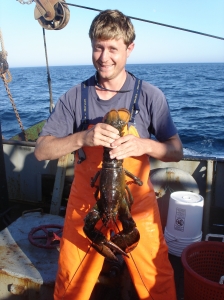It’s Tuesday and you know what that means by now if you’ve been following BCS this summer. Time for another installment of “What Marine Conservationists Are Into …”! This is a series I featured in the summer of 2012 to get a special sneak peek at the many different personalities behind the scientists, activists, and educators (including bloggers) who play an integral role in the marine science conservation field. It’s essentially an extension of the overwhelmingly popular and well done Tumblr blog, This Is What A Scientist Looks Like, (BCS was featured in April of 2012!) which sets out to illustrate that scientists are not just crazy haired nerds in lab coats. I sent a list of 15 random questions and asked that each person share at least their answers to 5 of them. For the tenth edition, I am delighted to introduce California conservationist extraordinaire, Dr. Wallace ‘J” Nichols.
 Dr. Wallace “J.” Nichols is a scientist, activist, community organizer, author, and dad. He works to inspire a deeper, more active, connection with nature, sometimes simply by walking and talking, other times through writing or images. Science and knowledge can also stoke our fires. But he knows that what really moves people is feeling part of and touching something bigger than ourselves.
Dr. Wallace “J.” Nichols is a scientist, activist, community organizer, author, and dad. He works to inspire a deeper, more active, connection with nature, sometimes simply by walking and talking, other times through writing or images. Science and knowledge can also stoke our fires. But he knows that what really moves people is feeling part of and touching something bigger than ourselves.
J. is a Research Associate at California Academy of Sciences and founder of several conservation initiatives including Ocean Revolution, an international network of young ocean advocates, SEE the WILD, an international conservation travel portal and LiVBLUE, a campaign to reconnect people with our water planet. He earned his Bachelors in Biology and Spanish from DePauw University, an MEM in Environmental Policy and Economics from Duke University’s Nicholas School, and his PhD in Wildlife Ecology and Evolutionary Biology from University of Arizona.
He advises a motivated group of international graduate students and serves as an advisor to numerous non-profit boards and committees as part of his commitment to building a stronger, more progressive, and connected environmental community.
Lately he is working on BlueMarbles.org and BLUEMiND: The Mind + Ocean Initiative. He blogs at wallacejnichols.org and lives on California’s SLOWCOAST.
What is the last thing you bought that you shouldn’t have?
I’ve been off coffee for almost a month. But I bought a “dirty chai tea” which has a shot of espresso hidden down in the glass of tea.
What is your favorite fruit flavor?
Organic local you-pick olallieberry, the season is so short and sweet. Always worth the wait.
What is your favorite Sunday breakfast?
Poached eggs from our chickens, fresh pesto, on sourdough bread. And a dirty chai ; )
What’s your favorite midnight snack?
Ice cream w/ olallieberries!
Are you a night owl or a morning person?
A massive night owl who loves early mornings.
What is your favorite room in your home?
My daughters’ room, because we read stories at night and snuggle. It’s the best part of the day and the house.
Which sitcom character do you relate to?
None. I put some thought into this. And, well, none. That probably explains why we don’t have a TV. Or vice versa.
What is your favorite scent?
So, so many. Can I say olallieberry again? Just kidding. Late on a cool night in the redwoods. Just after a rain in the Sonoran Desert. Any kind of pie.
What is your favorite sundae topping?
Guess.
What is your favorite pastime?
Anything with our kids. They really make anything we do so much fun.
What three things would you take with you to an island?
Shakepeare’s Complete Works. A good machete. Olallieberry seeds.
How superstitious are you?
Not a bit.
What is your favorite day of the week?
Thursday, or Thor’s Day. Named after the Norse god of thunder, lightning storms and oak trees. That’s just cool. I think about that every Thursday.
Are you a cat person, dog person, or neither?
Both. Their names are Fisher (Newfoundland), Jack Wilder (Cairn terrier), Penelope (Maine Coon) and Trout (strange but cute black cat)
If you were a geometric shape, what would you like to be?
I rather like the rhombus. I wouldn’t really want to be one, though.
What’s some other random favorite information about you?
My fascination with neuroscience began in college, when I was 19. I gave weekly guitar lessons to a woman who had lost her memory in an accident as therapy for restoring her memories, and it worked. I’ve been interested in the wonders of the human brain ever since.
Almost ten years ago my partner Dana and daughter Grayce (who was just 1 y.o., her sister Julia wasn’t born yet) walked 1,800 km from Oregon to Mexico along the coast. I highly recommend that everyone take a very long walk (months) through a place that is important to them. It’s a deeply human and transformative thing to do.
Image (c) Jeff Lipsky
















What people are saying …